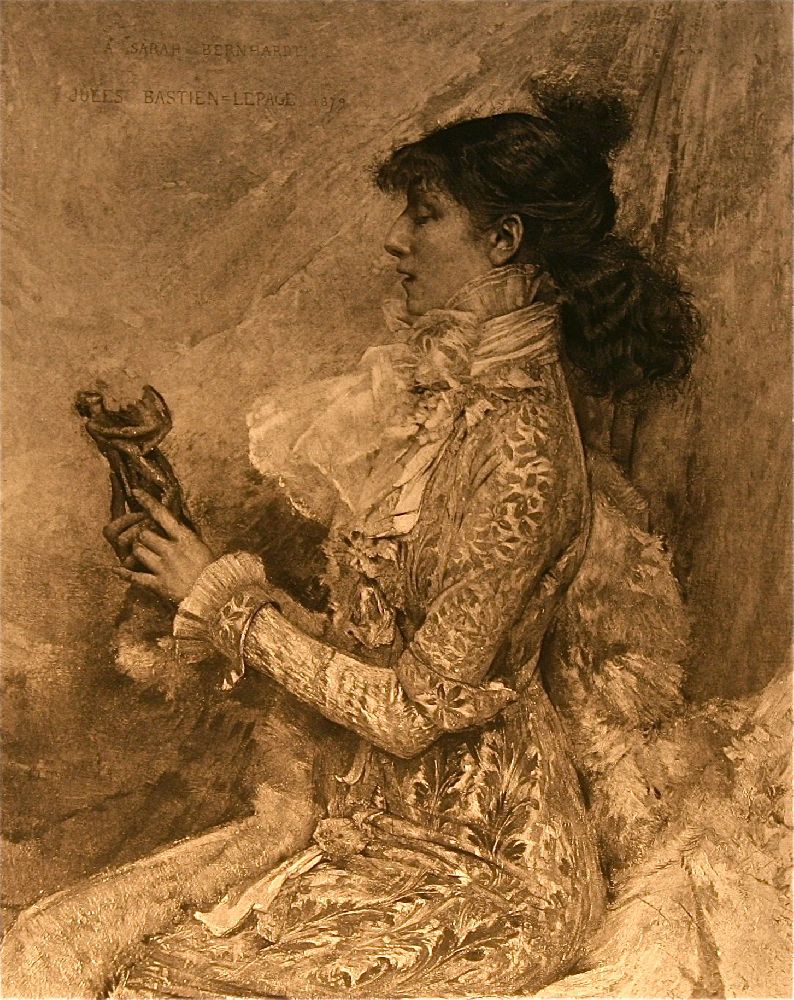

Title: Antique Print Of Sarah Bernhardt French Portrait Artist Jules Bastien
Shipping: $19.00
Artist: N/A
Period: 19th Century
History: N/A
Origin: Northern Europe > England
Condition: Very Good
Item Date: 1892
Item ID: 5849
Antique stone print Of Sarah Bernhardt by the artist Jules Bastien. 1892 Original Art portfolio Print (Photoxylograph). This antique print of Sarah Bernhardt is by Jules Bastien-Lepage. The print is on heavy stock paper that is blank on the reverse side. Some foxing on the print (adding to its charm), and a small tear on the top left corner. Otherwise, in good antique condition. Measures 11 inches wide by 14 inches high; actual image measures 7¾ by 9¾. This print was made from the portrait of Mlle Sarah Bernhardt, 1879. Oil on canvas. Ann & Gordon Getty Collection. In the Legion of Honor. Artist jules bastien - sarah bernhardt portrait painting. All of the art is edited and chosen by us for its high quality and workmanship before posting. We are committed to enhancing our customer’s lives by discovering creating, and pointing out only the best art we can find in the world today. We Are Taste-Makers, Art Advisers, Consultants & Publishers Of Spectacular Art Stories. Our job is to be intermediaries between buyers and sellers. We are vetting for high end art patrons. We are determined to catalog the world's most exceptional art and share it with everyone.
Link: http://en.wikipedia.org/wiki/Jules_Bastien-Lepage
Jules Bastien-Lepage (November 1, 1848 – December 10, 1884), was a French naturalist painter, a style following the Realist movement.
Bastien-Lepage was born in the village of Damvillers, Meuse, and spent his childhood there. Bastien's father grew grapes in a vineyard to support the family. His grandfather also lived in the village; his garden had fruit trees of apple, pear, and peach up against the high walls. Bastien took an early liking to drawing, and his parents fostered his creativity by buying prints of paintings for him to copy.
Jules Bastien-Lepage's first teacher was his father, himself an artist. His first formal training was at Verdun, and prompted by a love of art he went to Paris in 1867, where he was admitted to the École des Beaux-arts, working under Cabanel. He was awarded first place for drawing but spent most of his time working alone, only occasionally appearing in class. Nevertheless, he completed three years at the école. In a letter to his parents, he complained that the life model was a man in the pose of a mediaeval lutanist. After exhibiting in the Salons of 1870 and 1872 works which attracted no attention, in 1874 he made his mark with his Song of Spring, a study of rural life, representing a peasant girl sitting on a knoll looking down on a village. His Portrait of my Grandfather, exhibited in the same year, was not less remarkable for its artless simplicity and received a third-class medal.
When the Franco-Prussian war broke out, Bastien fought when men were needed for the troops. Bastien was a man by this time, medium height and stout. After the war, he returned home to paint the villagers. In 1873 he painted his grandfather in the garden, and this painting later became a favorite for many art lovers for its true-to-life qualities. In 1873 he was also commissioned to paint the Prince of Wales.
This success was confirmed in 1875 by the First Communion, a picture of a little girl minutely worked up as to color, and a Portrait of M. Hayern. In 1875 he took the second Prix de Rome with his Angels appearing to the Shepherds, exhibited again in 1878. His next endeavour to win the Grand Prix de Rome in 1876 with Priam at the Feet of Achilles was again unsuccessful (it is in the Lille gallery), and the painter determined to return to country life. To the Salon of 1877 he sent a full-length Portrait of Lady L. and My Parents; and in 1878 a Portrait of M. Theuriet and The Hayfield. The last picture, now in the Luxembourg, is regarded as a typical work from its stamp of realistic truth.